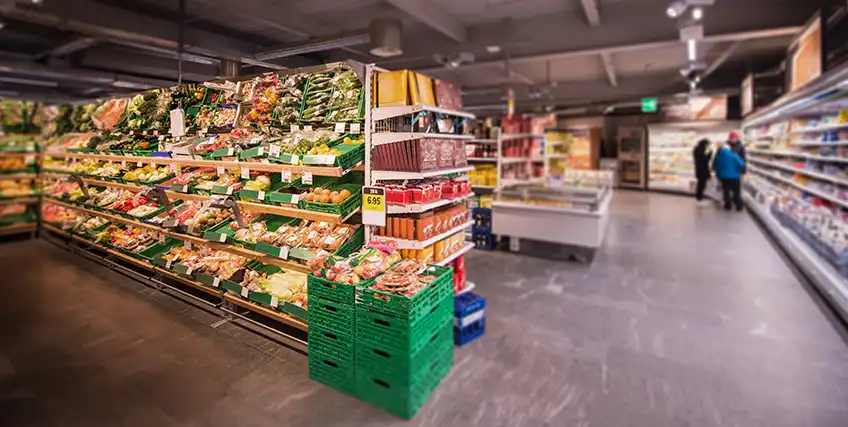Grocery Store Equipment Financing: Upgrade Your Store Without Breaking the Bank
April 01, 2025 | Last Updated on: April 02, 2025

Grocery store owners constantly face pressure to stay competitive. Outdated equipment—such as refrigeration units, shelving, and POS systems—can hinder a store’s efficiency and overall performance.
As a result, investing in upgrades is both necessary and routine in the grocery business.
To support these upgrades, capital equipment financing provides various funding options tailored to your store’s needs. In this article, we explore different financing solutions to help you modernize your grocery store equipment.
Why Invest in Upgraded Equipment?
Upgrading your grocery store’s equipment provides a lot of advantages:
- It increases operational efficiency. Modern, energy-efficient equipment reduces utility costs, directly enhancing your cash flow.
- It improves the customer experience. Modern refrigeration and shelving systems enhance product presentation and accessibility, while advanced POS systems streamline the checkout process, minimizing wait times.
- Upgrades can contribute to improved asset management. Newer equipment often comes with advanced monitoring and diagnostic tools, facilitating preventative maintenance and minimizing downtime.
- A better shopping environment fosters customer loyalty and repeat business, leading to increased sales.
Upgrading your grocery store's equipment is an investment in a more profitable, efficient, and customer-centric grocery store business.
Capital Equipment Financing Options
Supermarket business financing extends beyond traditional loans, encompassing avenues like capital equipment financing and, increasingly, revenue-based financing. Navigating supermarket store business financing requires understanding the specific needs of the grocery sector. Capital equipment financing enables targeted upgrades of essential assets, facilitating store renovations and securing vital working capital.
Understanding the various financing options in the realm of capital equipment financing is important for making informed decisions. Here’s a breakdown:
Term Loans
One type of capital equipment loan is a term loan. Term loans can be used for the purchase of capital equipment. They typically offer fixed or variable interest rates. Repayment terms are tailored to your business needs.
Term loans, within the context of capital equipment financing, allow you to own the equipment outright after fulfilling the financing terms. For many grocery owners, capital equipment loans offer a direct path to acquiring essential upgrades. Often, the equipment itself serves as collateral, simplifying the credit approval process.
Fixed rates provide predictable monthly payments, while variable rates fluctuate with market conditions. A down payment is an initial sum paid towards the equipment, reducing the loan amount. Origination fees are administrative charges for processing the loan.
Revenue-based financing
Revenue-based financing offers flexibility by tying repayment to a percentage of your store's estimated future receivables. While both types of financing provide tailored solutions, it's important to be aware that lenders, particularly for conventional supermarket business loans, often maintain rigorous approval standards.
Equipment Leasing
While equipment leasing is an option, capital equipment financing through loans allows for ownership, which can be advantageous. Equipment leasing allows you to use equipment for a specified lease term without owning it, offering lower upfront costs compared to purchasing, making it ideal for small business owners.
Equipment leasing can provide potential tax benefits, as lease payments may be tax-deductible. At the end of the lease term, you may have the option to purchase, renew, or return the equipment. Opt to lease equipment if you prefer to always have the latest models. Equipment leasing solutions avoid large upfront payments.
Line of Credit
A line of credit provides access to a predetermined amount of funds, allowing you to draw upon it as needed. This offers flexibility for unexpected expenses or short-term financing needs, acting as a renewable source of funds, unlike term loans.
Commercial Real Estate Loans
For grocery store owners looking to purchase or renovate their property, commercial real estate loans offer a distinct financing pathway. These loans are specifically designed for real estate acquisitions, expansions, or significant renovations, and typically feature longer repayment terms compared to equipment loans.
They often require a down payment and a thorough evaluation of the property's value and the borrower's financial stability. Commercial real estate loans can be secured with fixed or variable interest rates, and they provide the capital needed for long-term investments in physical infrastructure, which can enhance the store’s market value and operational capacity.
Upgrading Key Equipment
Upgrading key equipment like refrigeration, shelving, and POS systems, facilitated by capital equipment financing, can enhance your store's performance. Modern refrigeration systems are more energy-efficient, offer precise temperature control, and enhance product visibility.
Adjustable shelving maximizes space utilization and improves product organization, while modern designs enhance store aesthetics. Advanced POS systems streamline checkout, provide valuable data on sales and inventory, and enhance customer engagement through loyalty programs and mobile payment options. This contributes to solid asset management.
Choosing the Right Financing Option
Selecting the appropriate capital equipment financing option requires a review of your financing needs, a comparison of interest rates, financing terms, and monthly payments, and an evaluation of potential tax advantages and tax benefits.
Partnering with lenders and equipment financing companies with expertise in the grocery industry is important as they can help you navigate which loan might be right for you. Many lenders specialize in loan supermarkets, providing tailored solutions for the grocery industry. Ensure you fully understand all disclosures and payment options. Consider fixed rates to provide payment stability.
- Application Process and Credit Approval: The capital equipment financing application process typically involves preparing a business plan, gathering necessary financial documentation, and undergoing credit approval. Lenders will assess your annual revenue, credit history, and overall business stability.
- Working with Reputable Lenders: Ensure you partner with reputable lenders that are a member of FDIC and have a strong track record. Seek out equipment financing companies specializing in the grocery sector. Verify that the borrower fully comprehends the available financing programs.
- Tax Advantages and Benefits: Equipment purchases, and lease equipment can offer various tax benefits. Depreciation deductions may apply to purchased equipment, while lease payments could be tax-deductible. Always consult with a tax professional for personalized advice.
- Differences between Term Loans and Lines of Credit: Term loans provide a lump sum for a specific purpose, repaid over a fixed period with scheduled payments. A line of credit offers access to funds up to a credit limit, used as needed and repaid with interest.
- Differences between Fixed Rates and Other Rate Types: Fixed rates remain constant throughout the loan term, offering predictable payments. Variable rates fluctuate with market conditions, which could lead to unpredictable payment increases or decreases.
- Differences between Down Payment and Origination Fees: A down payment reduces the principal loan amount, while origination fees are administrative costs charged by the lender for processing the loan.
By navigating these key aspects of capital equipment financing, businesses can secure the optimal funding solution to support their growth and operational efficiency.
Industry Trends and Economic Impact
The USDA's push for a transformed grocery industry, driven by post-pandemic lessons and evolving consumer needs, emphasizes a more resilient, equitable, and localized food system. This shift means technological and infrastructural upgrades within grocery stores, including advanced POS systems, energy-efficient refrigeration, and expanded storage capabilities.
Such changes can be disruptive. However, they are ultimately needed to adapt to new market demands to ensure a sustainable supply chain, directly influencing the need for capital equipment financing.
Grocery stores rely on capital equipment financing to fund these essential upgrades. Investments in modern technology, infrastructure improvements, and energy-efficient solutions are needed for staying competitive and meeting the USDA's goals. Whether it's acquiring new display cases for locally sourced products, upgrading to more efficient HVAC systems, or implementing advanced inventory management technology, capital equipment financing will play a pivotal role in enabling grocery businesses to navigate inevitable change
Regulatory and Compliance Considerations
Grocery store owners must operate within a complex regulatory framework. The Food and Drug Administration (FDA) sets stringent standards for food safety and storage, requiring compliance with regulations related to refrigeration and handling.
The Environmental Protection Agency (EPA) also imposes regulations on the use of refrigerants and energy consumption. According to the Small Business Administration (SBA), understanding these regulations is crucial when planning equipment upgrades. Compliance with these standards not only ensures food safety but also avoids costly penalties.
Understanding and complying with these regulations is essential when upgrading grocery store equipment, but it can also add financial strain. Investing in compliant refrigeration, energy-efficient systems, and other regulated equipment often requires significant capital.
Bottom Line
Upgrading your grocery store with capital equipment financing can enhance efficiency, improve customer experience, and keep your business competitive. Whether you need energy-efficient refrigeration, modern shelving, or advanced POS systems, financing options like term loans and revenue-based financing offer flexible solutions to support these critical upgrades.
Investing in new equipment not only streamlines operations but also helps ensure compliance with industry regulations, reducing long-term costs and potential penalties. With the right financing strategy, you can future-proof your grocery store and drive sustainable growth.
Ready to modernize your grocery store with capital equipment financing? Explore flexible equipment financing solutions today. Learn more and see if you qualify with Biz2Credit.
FAQs about capital equipment financing
What are the primary advantages of equipment leasing over purchasing?
Leasing reduces upfront costs, offers potential tax benefits, and allows for more frequent equipment upgrades. This flexibility can be particularly beneficial for businesses looking to stay technologically current without a large initial capital outlay.
How can I enhance my chances of securing credit approval for a business loan?
Maintain a strong credit history, compile a business plan, and provide accurate financial statements. Demonstrating consistent revenue and a clear plan for repayment significantly improves your standing with lenders.
What types of equipment qualify for capital equipment financing?
Most essential grocery store equipment, including refrigeration, shelving, POS systems, and other types of equipment necessary for your business. This broad range ensures that businesses can finance nearly any operational need.
Are there specific tax advantages associated with equipment financing?
Lease payments may be tax-deductible, and depreciation deductions may apply to purchased equipment. Consulting a tax professional is essential to fully understand and leverage these potential benefits.
How do I find the most favorable interest rates for my equipment loan?
Compare offers from multiple providers, consider your credit score and business history, and negotiate the financing terms. Building relationships with lenders and understanding market rates can give you a strong negotiating position.




